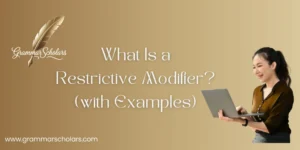Mastering the Subtleties of “My Question Is” in American English Grammar starts with knowing how tone and structure influence meaning. Navigating, grammar, expression, clarity, syntax, structure, communication, and context all play major roles in shaping how this phrase is received. It works like a signal-it introduces a thought with politeness while asserting intent. But poor structure can twist that meaning. Instead of enhancing clarity, it might confuse. Many learners make that mistake: using the phrase without understanding the nuance behind it.
The real key is not just knowing the rules but applying them with flexibility. Grammar, like a map, helps you steer through language effectively. When you say “My Question Is,” be sure it fits the situation and matches the tone. It’s not just about rules; it’s about making your message resonate. A pause or vocal tone can also change how it’s heard. In learning, we don’t just teach the phrase-we teach how to use it with confidence and purpose.
Unlocking the magic behind “My question is” takes more than grammar rules-it requires intuition, context awareness, and awareness of tone. In this guide, you’ll learn exactly when, why, and how to use this phrase correctly. We’ll explore punctuation, tone, alternatives, real-world examples, and even related grammar tips presented in a natural, easy-to-read style.
Why “My Question Is” Matters
Ever felt tangled when asking a question? You’re not alone. It often trip people up-especially in writing, where tone and clarity matter most. It’s not just a phrase; it signals curiosity, structure, and intent. Master it, and you’ll sound polished, thoughtful, and confident.
Breaking Down the Phrase “My Question Is”
At its heart, “My question is” follows the standard subject-verb pattern:
- My → possessive pronoun
- Question → noun
- Is → linking verb
That’s your foundation. What follows this phrase transforms your sentence into inquiry, reflection, or even persuasion.
Correct Punctuation After “My Question Is”
You might ask yourself: should it be a colon, comma, or nothing? Let’s break it down.
- Colon ( : ) introduces an explanation or list.
- The comma ( , ) sets up a dependent clause.
- No punctuation can work, but only in a quick, informal chat.
Punctuation isn’t decoration. It shapes meaning and rhythm.
Colon vs. Comma: Which One to Use, and When
Colon
Use a colon when what follows fully answers or explains:
My question is: “What time does the train arrive?”
Comma
Use a comma when what follows continues the flow:
My question is, why does the train run late today?
No punctuation
Casual chats allow flexibility:
My question is, are you free tonight?
| Punctuation | Best For | Example | Tone |
| Colon | Full answers/explanation | My question is: what time…? | Formal |
| Comma | Ongoing flow | My question is, why…? | Neutral |
| None | Quick spoken-style | My question is, are you free? | Informal |
Common Mistakes (and How to Fix Them)
- “My question is…”
“My question is, is this the best route?”
“My question is: is this the best route?” - No punctuation
“My question is, why delay?”
“My question is: why the delay?” - Redundancy
“My question is basically what happened?”
“What happened?”
Key fix: Choose your punctuation early, then stick to one clean clause.
Can “Is” Follow “My Question Is”? Grammar Unpacked
That second “is” often trips up non-native speakers. Here’s the breakdown:
- First is → linking verb.
- The second is → starts your question clause.
It works, but it sounds clunky. You can reframe:
- “My question is, is this enough?”
- “My question is: is this enough?”
- Or more streamlined: “Does this suffice?”
The Function of a Comma in Setting Up a Question
When you include a comma after “My question is,” you’re creating a subtle pause. That pause:
- Softens your tone
- Signals a shift from statement to question
- Ease the reader’s comprehension
Think of the comma as a verbal gesture-an invitation rather than a command.
Real-Life Contexts for “My Question Is”
Conversation
- “My question is, do you want coffee or tea?”
Casual, spontaneous it fits.
Workplace
- “My question is: can we adjust the deadline?”
Professional, structured punctuation matters here.
Formal Writing
- “My question is: why doesn’t the policy accommodate remote workers?”
Use it, but sparingly for critical reports or formal communications.
Is “My Question Is” Too Formal?
Yes and no. It’s formal by nature, but the tone depends on context:
- In conversations, it might feel stiff.
- In emails or reports, it conveys seriousness.
If you need a softer tone, try:
- “I’d like to ask…”
- “Here’s what I wonder…”
- “Can you tell me why…?”
These alternatives feel more approachable and less scripted.
Smart Alternatives to “My Question Is”
Let’s break them into tone categories:
| Your Tone | Alternative Phrase |
| Friendly | “I’m wondering…” |
| Direct | “Can you explain why…?” |
| Introductory | “I’d like to know…” |
| Formal | “May I inquire…” |
Examples:
- Formal: “May I inquire why the cost increased?”
- Casual: “I’m wondering if we can meet tomorrow.”
Switching phrases gives your message more personality and reduces repetition.
Making Your Question Clear and Engaging
Clarity over complexity, every time. Here’s how:
- Keep it short - less than 20 words.
- State your intent – begin with “can,” “why,” and “how.”
- Avoid filler words – like “just,” and “basically.”
- Direct wording – ask the thing you need to know.
Ask sharp, and you’ll get sharp answers.
Sentence Structure & Grammar Behind the Scenes
Under that polished question lies grammar that influences tone.
- Independent clause: stands alone (My question is…)
- Dependent clause: needs a main clause (…why it’s delayed.)
- Appositive: a phrase renaming your question (My question, why it’s delayed…)
When you combine them properly with punctuation craft clarity and rhythm.
Usage Examples in Different Formats
| Format | Bad Example | Revised Example |
| My question is, can we update the timeline? | My question is: can we update the timeline? | |
| SMS | My question is when u coming? | I’m wondering when you’re coming. |
| Meeting Script | My question is, is the budget approved? | My question is: has the budget been approved? |
| Formal Letter | My question is why the policy lacks flexibility | My question is: Why does the policy lack flexibility? |
See how simple tweaks enhance readability and tone?
What Not to Say: Overused or Awkward Variants
Avoid:
- “My question is…” (double is)
- “My question is…” (wordy)
- “I just wanna know…” (too informal in writing)
Native speakers tend to use sharper phrasing-short, direct, and reader-friendly.
When to Rephrase Entirely
Sometimes, stepping away from “my question is” is best. Consider:
- Passive to active: “It would be helpful to know why the timeline changed.”
- Question first: “Why was the timeline changed?”
- Contextual setup: “I noticed the timeline changed you explain why?”
These techniques avoid puffiness and get straight to the point.
Listening Like a Native: Perceived Tone
How people hear your question matters:
- With colon → serious, structured.
- With comma → conversational, neutral.
- No punctuation → hurried or inefficient.
To adjust tone, read aloud or imagine saying it in a conversation. If it sounds robotic, you’ll know it needs a tweak.
Quick Grammar Lessons (Related Topics)
These mini-lessons help reinforce proper usage:
Clauses: Defining vs. Non-defining
- Defining clause: The question that matters is…
- Non-defining clause: My question, which I’ll pose now, is…
“Too Funny” vs. “TooFunny”
- Saying something’s too funny means it’s extremely humorous.
“Between You and I” vs. “Between You and Me”
- Between you and me is grammatically correct. “Me” is an object pronoun.
“Lots of Love”
- Perfectly normal in closings or casual notes need to overthink.
“Much Thanks”
- Less common in American English. Better to say “Thanks so much” or “Many thanks.”
The Definite Article “The”
- Use the when referring to something specific. e.g., “the policy” not “policy” if it’s already known.
Live Case Studies
Startup Pitch Email
“My question is: can we secure Series A funding by Q3?”
Strong, precise, and goal-oriented.
Customer Support Chat
“My question is, can you send me the tracking number?”
Warm, polite, and direct.
Academic Paper
“My question is: why do these patterns recur in 19th-century literature?”
Formal, structured, and scholarly.
Ask Better Questions in English
The secret to a polished “my question is” lies in purpose, punctuation, and tone. Use colons to introduce, commas to soften, and no punctuation only in casual chat. Choose alternatives when you need warmth or brevity. Always structure for clarity and rhythm. Every time you ask, you’re not just seeking answers-you’re practicing precision in communication.
Final Takeaway
Refine your phrasing. Be intentional. Invite engagement. That’s how you make every question count.
Final Thoughts
Mastering the phrase “my question is” in American English isn’t just about grammar- it’s about clear, confident communication. Whether you’re writing an email, participating in a meeting, or just chatting with friends, the way you phrase your question shapes how it’s received.
By understanding the difference between using a colon, comma, or no punctuation, you improve both the clarity and tone of your message. Knowing when to use this phrase, when to skip it, and how to replace it empowers you to communicate with intention and precision.
Remember: language is a tool, not a rulebook. You don’t need to sound robotic or overly formal. The goal is to be understood and to engage. Whether you’re crafting a formal inquiry or starting a casual conversation, asking better questions helps build stronger relationships, resolve issues faster, and demonstrate emotional intelligence.
So next time you find yourself typing, “My question is…” – pause and ask: What tone do I want? What outcome do I need? Then frame your sentence with clarity, purpose, and impact.
FAQs
What punctuation should come after “My question is”?
A colon is most appropriate when you’re introducing a full, direct question (especially in formal writing). Use a comma for a softer tone or ongoing thought, and no punctuation in informal speech or quick messages.
Is it grammatically correct to say “My question is”?
Technically, yes, but stylistically it’s clunky and redundant. The double “is” occurs when the phrase is followed by a question starting with “is.” A better option is to insert a colon:
My question is: Is this the best route?
Is “My question is” too formal for daily conversations?
Yes, it can sound a bit stiff in casual conversations. Instead, try alternatives like:
- “Can I ask…”
- “I’m wondering…”
- “What do you think about…”
These feel more natural and engaging in everyday use.
Can I use “My question is” in professional emails?
It is with clear punctuation and only when necessary. For instance:
“My question is: how will this impact Q4 targets?”
It works well when you’re highlighting a focused point in a long message.
What are some better alternatives to “My question is”?
Depending on tone and audience, you can say:
- “I’d like to ask…”
- “Could you explain…”
- “What’s the reasoning behind…”
These phrases are often shorter, friendlier, and more effective.











